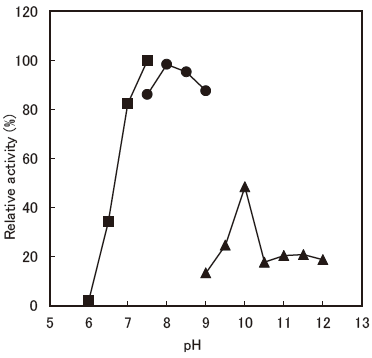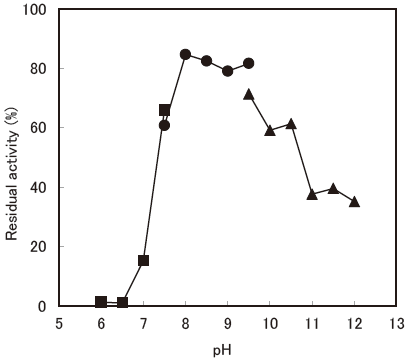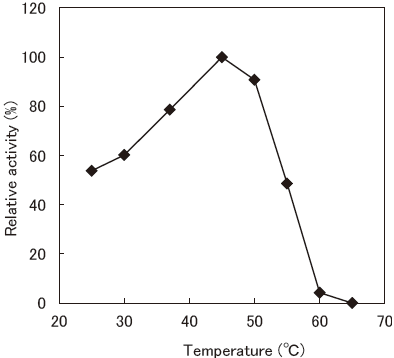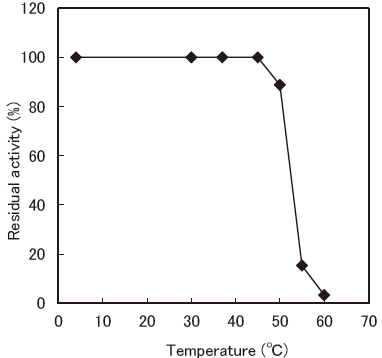SARCOSINE OXIDASE [SOXG]
from Bacillus sp.
(Sarcosine: oxygen oxidoreductase, EC 1.5.3.1)
Sarcosine + O2 + H2O → Glycine + HCHO + H2O2
Preparation and Specification
- Appearance
- : Yellowish amorphous powder, lyophilized
- Specific activity
- : More than 30 U/mg solid
Properties
- Substrate specificity
- : See Table 1
- Molecular weight
- : 41 kDa (gel filtration)
- Isoelectric point
- : pH 4.8
- Michaelis constants
- : Sarcosine 3.4 × 10-2M
- Optimum pH
- : 7.5–8.5Figure 1
- pH stability
- : 8.0–9.5 (50℃, 10 min) Figure 2
- Optimum temperature
- : 45–50℃ (pH8.0, 20mM Tris–HCl buffer) Figure 3
- Thermal stability
- : Stable at 45℃ and below ( pH 7.5, 10 min) Figure 4
- Effect of various chemicals
- : See Table2, Table3
Applications for Diagnostic Test
This enzyme is useful for enzymatic determination of creatinine when coupled with creatinase and creatininase.
| CRN | ||
| Creatinine + H2O | → | Creatine |
| CR | ||
| Creatine + H2O | → | Sarcosine + Urea |
| SOXG | ||
| Sarcosine + H2O + O2 | → | Glycine + HCHO + H2O2 |
| POD | ||
| 2 H2O2 + 4-AA + Phenol | → | Quinoneimine dye + 4 H2O |
Table 1. Substrate specificity
| Substrate | Relative activity (%) |
|---|---|
| Sarcosine | 100 |
| N-ethylglycine | 11 |
| Formylglycine | 0 |
| N,N-dimethylglycine | 0 |
| Glycine | 0 |
| Proline | 0 |
Table 2.Effect of various chemicals on SOXG stability (55℃, 10 min)
| Additive | Concentration | Residulal activity (%) |
|---|---|---|
| None | 41 | |
| FAD | 20μM | 30 |
| KCl | 0.3M | 101 |
| FMN | 10μM | 21 |
| EDTA | 1mM | 20 |
| Sucrose | 20% | 80 |
| Ethyleneglycol | 20% | 2 |
| Glycerol | 20% | 61 |
FMN : Flavin mononucleotide
Table 3. Effect of various chemicals on SOXG activity
| Additive | Concentration | Residulal activity (%) |
|---|---|---|
| None | 100 | |
| MgCl2 | 0.5mM | 99 |
| MnCl2 | 0.5mM | 102 |
| CaCl2 | 0.5mM | 97 |
| LiCl2 | 0.5mM | 96 |
| CuCl2 | 0.5mM | 94 |
| Ba(CH3COO)2 | 0.5mM | 100 |
| NaCl | 0.5mM | 98 |
| CoCl2 | 0.5mM | 76 |
| FeCl2 | 0.5mM | 76 |
| KCl | 0.5mM | 96 |
| EDTA | 1.0mM | 98 |
| Triton X-100 | 0.1% | 99 |
| Sodium Cholate | 0.1% | 92 |
| Tween 80 | 0.1% | 102 |
Fig.1 pH Optimum

●: Tris-HCl buffer
▲: Glycine-NaOH buffer
Fig.2 pH Stability

●: Tris-HCl buffer
▲: Glycine-NaOH buffer
Fig.3 Optimum Temperature

20mM Tris-HCl buffer
Fig.4 Thermal Stability

10mM Phosphate buffer
Assay
Principle
The assay is based on the increase in absorbance at 480 nm as the formation of quinoneimine dye proceeds in the following reactions:
| SOXG | ||
| Sarcosine+O2+H2O | → | Glycine+HCHO+H2O2 |
| POD | ||
| 2 H2O2+4–AA+Phenol | → | Quinoneimine dye+4 H2O |
Unit definition
One unit is defined as the amount of enzyme which oxidizes 1 μmole of sarcosine to glycine per minute at 37℃ under the conditions specified in the assay procedure.
Reagents
- Reaction mixture
0.2M Tris–HCl buffer pH 8.0 0.05 ml 1.0M Substrate solution (Sarcosine) 0.10 ml 100U/ml POD solution 1) 0.025 ml 15mM 4–AA solution 0.05 ml 0.2% (W/V) Phenol solution 0.05 ml Distilled water 0.225 ml 1) 100 U/ml POD solution
Dissolve 1,000 U (PPU) of POD with 10 ml of distilled water. - Reaction stopper
Ethanol - Enzyme dilution buffer
10 mM KH2PO4 –K2HPO4 buffer pH 7.5 - Reagents
Sarcosine (N–methylglycine or methylaminoacetate) :Tokyo Kasei Kogyo Co., Ltd. Special grade #M0332
4–AA: NACALAI TESQUE, INC. Special grade #01907–52 POD: Sigma Chemical Co. Type Ⅱ # P–8250
Enzyme solution
Accurately weigh about 20 mg of the sample and add enzyme dilution buffer to make a total of 20 ml. Dilute it with enzyme solution buffer to adjust the concentration as required.
Procedure
- Pipette accurately 0.5 ml of reaction mixture into a small test tube and preincubate at 37℃.
- After 5 min, add exactly 10 μl of enzyme solution and mix to start the reaction at 37℃.
※ In the case of a test blank, add 10 μl of enzyme dilution buffer in place of enzyme solution. - At 5 min after starting the reaction, add 2.50 ml of the reaction stopper to stop the reaction.
- Measure the absorbance at 480 nm.
△A = (As−Ab) ≦ 0.125 AbsAbsorbance sample : As blank : Ab
Calculation
Activity (U/mg of powder) = {(△A/5) /(17.14×1/2)}× 3.01/0.01 × 1/x17.14 : millimolar extinction coefficient of quinoneimine dye at 480 nm (cm2 / μmole) 1/2 : a multiplier derived from the fact that 2 mole of H2O2 produces 1 mole of quinoneimine dye 5 : reaction time (min) 3.01 : final volume (ml) 0.01 : volume of enzyme solution (ml) X : concentration of the sample in enzyme solution ( mg/ml)
Storage
Storage at −20℃ in the presence of a desiccant is recommended. The enzyme activity will be retained for at least one year under this condition.
References
- Mori, N., Sano, M., Tani, Y. and Yamada, H. (1980)
Agric. Biol. Chem., 44, 1391–1397.
Proc., 13, 734–738. - Suzuki, M. and Yoshida, M. (1976) Proceedings of the Symposium on Chemical Physiology and Pathology
(Kyoto) , Vol. 16, 220. - Suzuki, M. (1981) J. Biochem., 89, 599–607.
- Kinoshita, T. and Hiraga, Y. (1980) Chem. Pharm. Bull., 28, 3501–3506.
Bacteriol., 160, 273–278.
SOXG 活性測定法 (Japanese)
試薬液
- 反応試薬混合液
0.2M トリス–HCl 緩衝液 pH8.0 0.05 ml 1M 基質溶液 (サルコシン) 0.10 ml 15mM 4–AA 溶液 0.05 ml 0.2% (W/V) フェノール液 0.05 ml 100U/ml POD 溶液 1) 0.025 ml 精製水 0.225 ml 1) : 100U/ml POD 溶液
POD 1,000 単位 (PPU) を精製水10ml で溶解する。 - 反応停止液
エタノール原液を用いる。 - 酵素溶解希釈用液
10mM KH2PO4–K2HPO4 緩衝液 pH7.5 - 試薬
サルコシン (N–メチルグリシン又はメチルアミノ酢酸) :東京化成製 特級 #M0332
4–AA:ナカライテスク製 特級 #01907–52
POD:シグマ製 Type Ⅱ #P–8250
酵素試料液
- 検品約20mg を精密に量り、酵素溶解希釈用液で全容20ml とする。
その液を酵素溶解希釈用液で適宜希釈する。
測定操作法
- 小試験管反応試薬混合液0.50ml を正確に分注し、37℃で予備加温する。
- 5 分経過後、酵素試料液10 μl を正確に加えて混和し、37℃で反応を開始する。
※ 盲検は酵素試料液の代わりに酵素溶解希釈用液10μl を加える。 - 5 分経過後、反応停止液2.50ml を加えて混和し、反応を停止する。
- 480nm における吸光度を測定する。
求められた吸光度の試料液はAs、盲検液はAb とする。
ΔA = (As−Ab) ≦ 0.125 Abs
計算
活性 (U/mg) = {(△ A/5)/ (17.14 × 1/2)}× 3.01/0.01 × 1/x| 17.14 : | キノンイミン色素の480nm におけるミリモル分子吸光係数 (cm2 / μmole) |
| 1/2 : | H2O2 2 モルからキノンイミン色素1 モルが生成することによる係数 |
| 5 : | 反応時間 (min) |
| 3.01 : | 反応総液量 (ml) |
| 0.01 : | 反応に供した酵素試料液量 (ml) |
| X : | 酵素試料液中の検品濃度 (mg/ml) |
